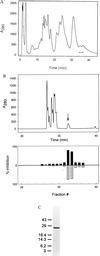Pseudechetoxin: a peptide blocker of cyclic nucleotide-gated ion channels
- PMID: 9892706
- PMCID: PMC15209
- DOI: 10.1073/pnas.96.2.754
Pseudechetoxin: a peptide blocker of cyclic nucleotide-gated ion channels
Abstract
Ion channels activated by the binding of cyclic nucleotides first were discovered in retinal rods where they generate the cell's response to light. In other systems, however, it has been difficult to unambiguously determine whether cyclic nucleotide-dependent processes are mediated by protein kinases, their classical effector enzymes, or cyclic nucleotide-gated (CNG) ion channels. Part of this difficulty has been caused by the lack of specific pharmacological tools. Here we report the purification from the venom of the Australian King Brown snake of a peptide toxin that inhibits current through CNG channels. This toxin, which we have named Pseudechetoxin (PsTx), was purified by cation exchange and RP-HPLC and has a molecular mass of about 24 kDa. When applied to the extracellular face of membrane patches containing the alpha-subunit of the rat olfactory CNG channel, PsTx blocked the cGMP-dependent current with a Ki of 5 nM. Block was independent of voltage and required only a single molecule of toxin. PsTx also blocked CNG channels containing the bovine rod alpha-subunit with high affinity (100 nM), but it was less effective on the heteromeric version of the rod channel (Ki approximately 3 microM). We have obtained N-terminal and partial internal sequence data and the amino acid composition of PsTx. These data indicate that PsTx is a basic protein that exhibits some homology with helothermine, a toxin isolated from the venom of the Mexican beaded lizard. PsTx promises to be a valuable pharmacological tool for studies on the structure and physiology of CNG channels.
Figures




References
-
- Meinkoth J L, Alberts A S, Went W, Fantozzi D, Taylor S S, Hagiwara M, Montminy M, Feramisco J R. Mol Cell Biochem. 1993;127-128:179–186. - PubMed
-
- Francis S H, Corbin J D. Annu Rev Physiol. 1994;56:237–272. - PubMed
-
- Finn J T, Grunwald M E, Yau K-W. Annu Rev Physiol. 1996;58:395–426. - PubMed
-
- Zimmerman A L. Curr Opin Neurobiol. 1995;5:296–303. - PubMed
-
- Rieke F, Schwartz E A. Neuron. 1994;13:863–873. - PubMed
Publication types
MeSH terms
Substances
Grants and funding
LinkOut - more resources
Full Text Sources
Molecular Biology Databases

